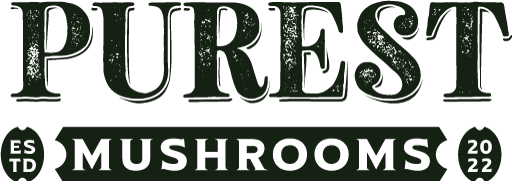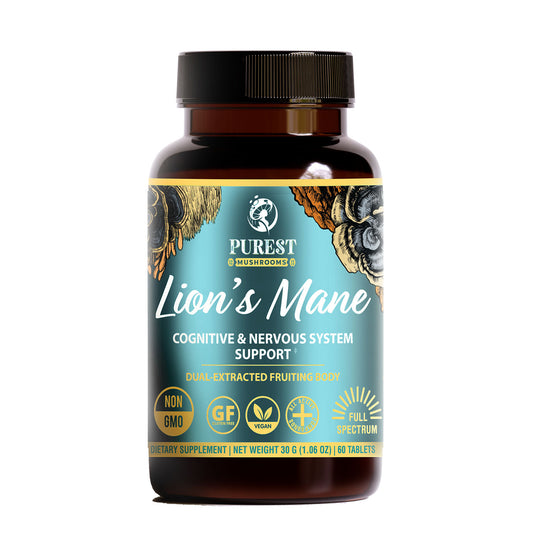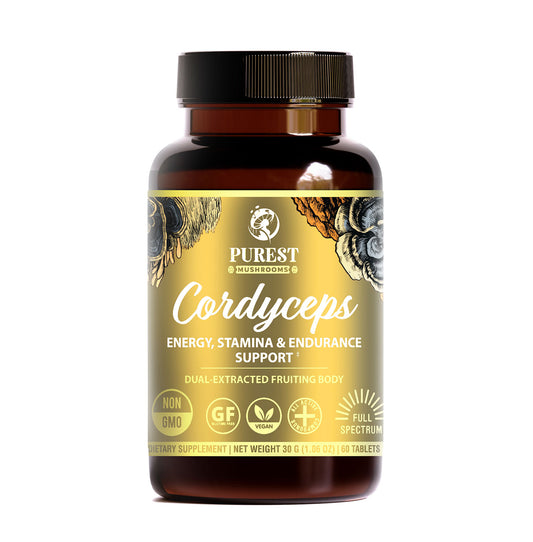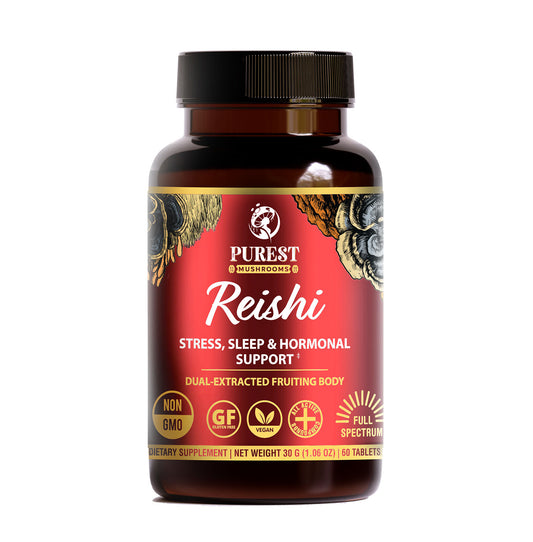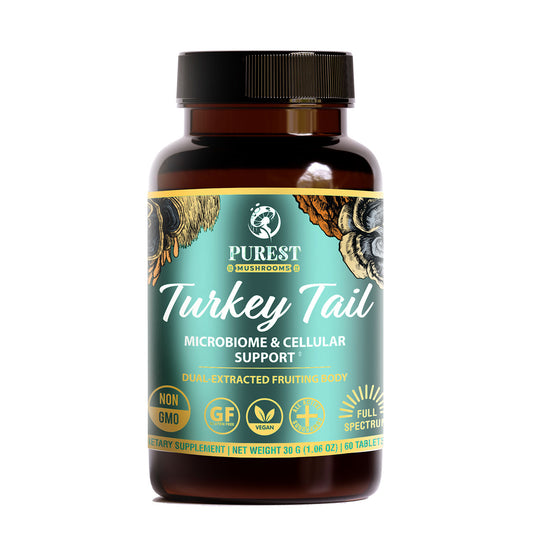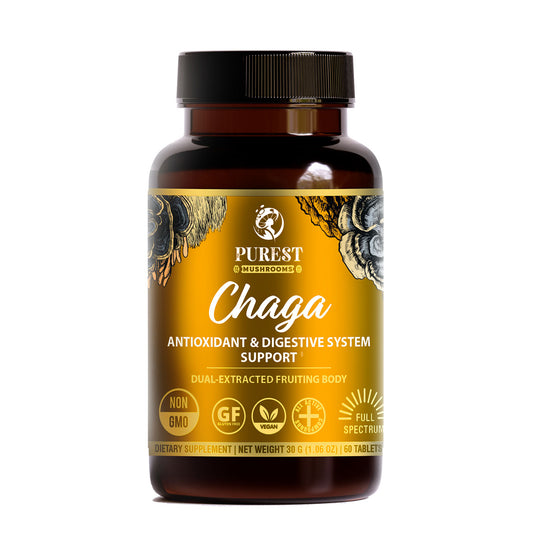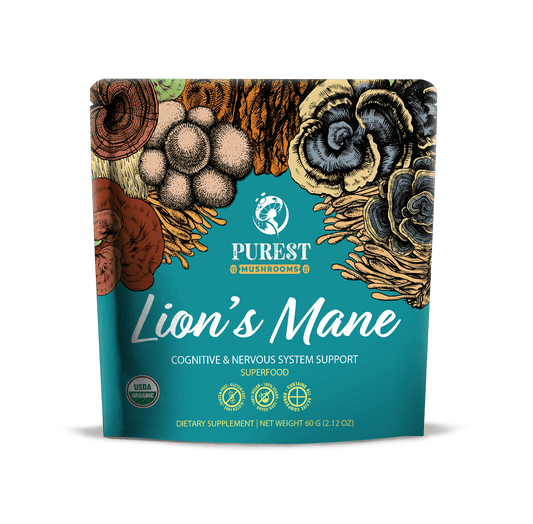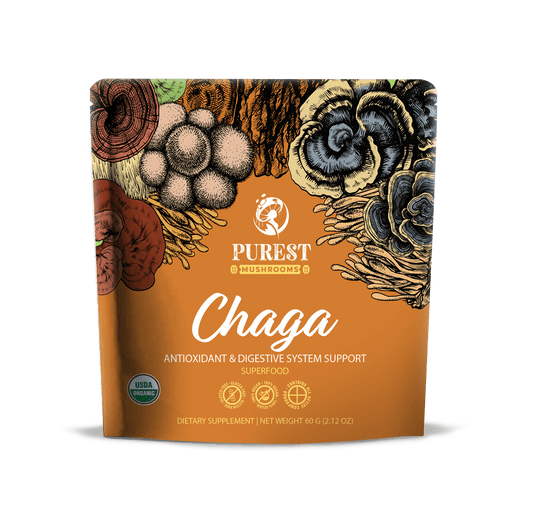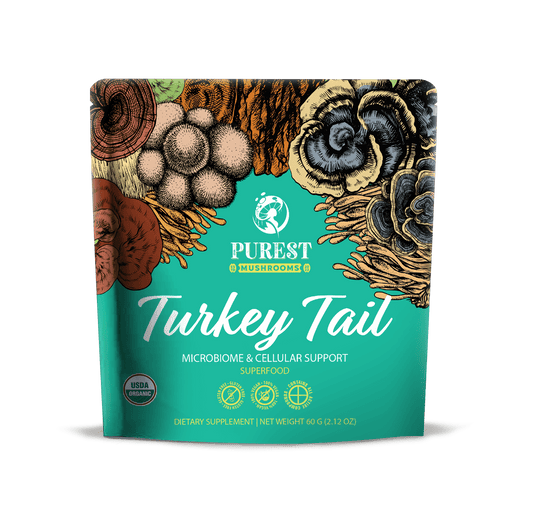A New Study Exposes Authentic Misleading Chaga Products
Chaga mushroom supplements are growing in popularity for their potential health benefits – but are you really getting authentic Chaga extract or something else? A recent scientific study compared several Chaga products and found big differences in quality and contents . In this post, we’ll break down the key findings in simple terms, highlight concerns about product authenticity and mislabeling, and compare those findings with Purest Mushrooms’ own practices. By the end, you’ll know how to choose quality mushroom supplements and avoid the imposters.
Understanding Chaga
What is Chaga Mushroom?
Chaga mushroom (Inonotus obliquus) is a type of parasitic fungus that primarily grows on birch trees, including paper birch (Betula papyrifera) and yellow birch (Betula alleghaniensis). Often referred to as the “Black Gold of the North,” chaga is renowned for its unique properties and numerous health benefits. Unlike typical mushrooms, chaga is not a fruiting body but a sclerotium—a hardened mass of mycelial tissue and wood. This fungus has a rich history of traditional use in folk medicine across Europe and Asia, where it has been prized for its adaptogenic properties and high antioxidant content. Chaga’s ability to thrive in harsh northern climates and its symbiotic relationship with birch trees make it a fascinating and valuable medicinal marvel.
What the Chaga Mushrooms Supplement Study Found
A 2025 study in the International Journal of Molecular Sciences tested five commercially available Chaga mushroom supplements . The researchers included one genuine wild-harvested Chaga extract and four other products made from lab-grown Chaga mycelium (the fungus’s root-like stage) on grain** **. Here’s what they discovered:
• All Chaga is Wild – So What Are “Cultivated” Products? Chaga (scientific name Inonotus obliquus) grows as a sterile conk (canker) on birch trees in cold northern forests . It cannot be farmed like typical mushrooms, so any “USA-grown” Chaga supplement is actually mycelium grown on a grain substrate (not the true black conk from birch) . The study confirms this is a major authenticity issue: some North American supplements misrepresent mycelium-on-grain as “Chaga mushroom”.
• Wild Chaga vs. Mycelium Products – Composition: The authentic wild Chaga (and its extract) was rich in unique compounds like triterpenoids (e.g. inotodiol, betulinic acid) and had the dark brown-black color from abundant melanin . In contrast, the mycelium-based products were beige in color and lacked those signature compounds entirely – the lab tests found none of the key triterpenoids in the grain-based products . The wild Chaga extract clustered chemically with real Chaga, whereas the grain-grown samples were completely different.
• High Beta-Glucans vs. High Starch: Chaga is prized for its beta-glucans (healthy fungal polysaccharides). The genuine Chaga samples contained about 5–12% beta-glucans and active compounds. The mycelium products? Their beta-glucan content was much lower – similar to the grains they were grown on. Instead, what they had a lot of was alpha-glucans, which is basically starch from the grain. An iodine starch test visually showed the mycelium products turning purple (positive for starch), while pure Chaga did not .
• “Mushroom” vs. Mycelium – Why It Matters: Because Chaga grows on birch trees, it absorbs unique precursors from the wood – for example, birch bark contains betulin, which Chaga converts into betulinic acid, inotodiol, and other bioactive triterpenes. These compounds are believed to contribute to Chaga’s health effects. A lab-grown mycelium on rice or oats never gets those birch compounds, so it can’t synthesize the hallmark triterpenoids. The study’s chromatography and NMR analyses highlighted this stark difference: only wild Chaga had those special metabolites, while the mycelium-on-grain products were missing them. In short, mycelium products were nutritionally closer to the grain itself than to real Chaga.

Why These Findings Matter for Consumers
For the health-conscious consumer, the study’s findings raise some red flags and important lessons:
• Potency and Efficacy: If you’re taking Chaga for its antioxidants, beta-glucans, or skin-supporting triterpenes, a mycelium-on-grain product may be letting you down. The research showed that authentic wild-harvested Chaga (or a true Chaga extract) provides those compounds – inotodiol, trametenolic and betulinic acids, melanins, etc. – whereas several store-bought “Chaga” supplements had none of those markers . Essentially, many cheap Chaga pills and powders are giving you a lot of oats or rice starch. That’s fine for calories, but not for medicinal mushroom benefits. It’s a bit like buying a ginseng supplement that turns out to be mostly powdered rice – you wouldn’t get what you paid for.
• Authenticity and Label Transparency: The study highlights a broader issue of authenticity in the mushroom supplement industry. When a label says “Chaga mushroom,” you’d expect it to be made from the actual mushroom (canker) part. In reality, several U.S. companies are selling myceliated grain products that are not the same part of the fungus traditionally used . This isn’t always obvious to consumers. This can definitely be misleading. Mislabeling not only deceives customers, but it also erodes trust in the whole supplement category. The researchers specifically warn about this misrepresentation problem, urging better quality control and honesty in marketing .
• Safety and Sourcing Concerns: On the flip side, what about the companies’ arguments that wild Chaga could be contaminated or over-harvested? There is truth there – Chaga is slow-growing and increased demand has led to heavy foraging. Wild Chaga can accumulate environmental contaminants if harvested from polluted areas . Responsible suppliers should address this with sustainable sourcing and rigorous testing. (We’ll discuss Purest Mushrooms’ approach in a moment.) Consumers should be aware that “organic USA-grown” Chaga supplements are not immune to quality issues either – they just differ (e.g. more filler, fewer actives, but likely no heavy metals). Ideally, a quality product will combine authenticity with safety testing.

Sustainable Harvesting Practices
Harvesting Chaga Responsibly
Harvesting chaga mushroom requires a deep understanding of the fungus and a commitment to sustainable practices to ensure both the longevity of the chaga and the health of its host tree. Responsible harvesting involves adhering to the “One-Third Rule,” which suggests that only one-third of the chaga should be harvested at a time. This method allows the remaining two-thirds to continue growing and reproducing, ensuring that the fungus can thrive and be available for future harvests. By following this approach, foragers can help maintain the delicate balance of the ecosystem, allowing chaga to continue providing its numerous benefits for years to come. Sustainable harvesting not only protects the chaga mushroom but also supports the health of the birch trees it grows on, ensuring a symbiotic relationship that benefits both the fungus and the forest.
The Science Behind Chaga’s Benefits
Biologically Active Compounds in Chaga
Chaga mushroom is packed with a variety of biologically active compounds that contribute to its impressive medicinal properties. Among these, betulinic acid, beta-glucans, and antioxidants stand out for their significant health benefits. Betulinic acid, derived from the birch bark that chaga grows on, has been shown to possess anti-inflammatory properties. Beta-glucans, a type of polysaccharide, are known for their ability to stimulate the immune system, enhancing the body’s response to infections. Additionally, the antioxidants found in chaga, such as melanin and polyphenols, help protect the body from oxidative stress and damage caused by free radicals. Together, these compounds provide a range of health benefits, including immune system support, anti-inflammatory effects, and potent antioxidant activity, making chaga a powerful addition to any wellness regimen.
Purest Mushrooms vs. The Rest: Our Commitment to Quality and Integrity

At Purest Mushrooms, we were excited to see this study shed light on the differences in Chaga products. It validates what we’ve always believed: quality comes from authenticity, transparency, and rigorous standards. Here’s how Purest Mushrooms’ practices compare, and why you can feel confident about our Chaga mushroom supplements:
• 100% Wild-Harvested Chaga Fruiting Body: We only use real Chaga conks (the black hardened mass from birch trees) – just like the “wild” samples in the study. Our Chaga is sustainably wildcrafted in the prime birch forests of Siberia, Canada, and the northern US . We never use mycelium grown on grain as a shortcut. That means our Chaga extract starts with the actual part of the fungus that nature intended for herbal use. As the study showed, nothing can truly replace wild-harvested Chaga when it comes to the full spectrum of compounds.
• Dual Extraction for Maximum Efficacy: Raw Chaga is very tough and full of indigestible fiber (it even contains chitin, like a shell). Traditional usage involves boiling it for hours. Purest Mushrooms uses a patented dual-extraction process (hot water AND alcohol) to draw out both water-soluble polysaccharides and alcohol-soluble triterpenoids from the Chaga conk . This ensures our final powder is a potent, concentrated Chaga mushroom extract – rich in beta-glucans, polyphenols, melanin, and terpenes. In fact, our product specifications guarantee a minimum level of beta-D-glucans and we can confidently say it contains the triterpenoids that many grain-based products lack. We essentially mirror what was tested as the “Chaga canker extract” in the study – which showed all the markers of true Chaga .
• No Fillers, Starch, or Grain – Ever: When you buy from Purest Mushrooms, you’re getting pure extract and nothing else. Our motto is “100% mushroom, 0% nonsense.” We don’t bulk out our capsules with rice powder or add myceliated grain. The study found some products were mostly starch – with Purest Mushrooms, the only starch you’ll find is the trace amount naturally present in the mushroom itself (<2% in wild Chaga ). This is a crucial point for us. Many customers come to us after realizing other brands had a lot of filler. We take pride in delivering a clean product – if it’s not mushroom, it’s not in our product.
• Transparency in Labeling and Testing: We believe you have a right to know exactly what you’re consuming. That’s why our labels clearly state “100% Chaga conk extract (fruiting body)” and we never use confusing terms like “mycelial biomass” to mask ingredients. Additionally, every batch of Purest Mushrooms Chaga is tested for purity and safety – including heavy metals, pesticides, and microbial contaminants . Yes, wild Chaga can carry some risk of environmental contaminants, so we mitigate that by careful sourcing (remote, unpolluted regions) and rigorous lab testing before the product reaches you. This way you get the best of both worlds: the authentic chemistry of wild Chaga, and the assurance of purity and safety. It’s worth noting that while some competitors grow mycelium to avoid contaminants, we prove that wild-sourced can be just as safe when handled correctly. We even test for beta-glucan content to verify potency, something many companies don’t do (if they did, the high starch content of some “mushroom” products would be impossible to hide!).
• Ethical and Sustainable Practices: Purest Mushrooms is committed to sustainable harvesting. We work with foragers who follow ethical guidelines – only a portion of Chaga from any tree is taken, and areas are allowed to regenerate. We are acutely aware of Chaga’s slow growth; by sourcing from vast Siberian forests and partnering with local communities, we support both the environment and economies. Unlike companies that might sidestep the issue by growing mycelium (thereby offering a fundamentally different product), we tackle sustainability head-on while still providing the real thing. We also educate consumers (like in this post!) so you know what you’re buying. Integrity is our core value, and we want the mushroom supplement industry to move in that direction as well.
How to Choose a Quality Chaga Supplement – Tips for Consumers
With all this information, how can you as a consumer ensure you’re getting a quality Chaga mushroom supplement and not a mislabeled imposter? Here are some quick tips to put into practice:
• Check the Ingredients: Look at the supplement facts panel back of the label. Does it mention “mycelium on brown rice” or “mycelial biomass”? If you see any grain or mycelium mentioned, know that it’s not an extract of the actual mushroom (canker) . High-quality products will specify fruiting body or wild Chaga.
• Consider the Origin: Because Chaga cannot be farm-cultivated as a conk , anything labeled “USA grown” is likely mycelium. Authentic Chaga will usually be wild-harvested from Northern regions (Canada, Siberia, Alaska, etc.). There are a few exceptions where cultivated mycelium is used intentionally, but at least you’ll know what you’re getting. If a company claims to have “organic Chaga mushrooms grown in California labs,” understand that means mycelium (and personally, I’d steer clear).
• Look for Extracts, Not Raw Powder: Chaga’s beneficial compounds are locked in a very tough matrix. If you buy raw Chaga powder (ground up conk or, worse, ground myceliated grain), you might not absorb much of anything. Opt for products that are extracts (dual-extracted if possible) as they will have more bioavailable beta-glucans and polyphenols. The product should mention if it’s an extract and often will list ratios or standardized levels (e.g. “30% polysaccharides” or “>10% beta-glucans”). “Authentic Chaga extract” is a key phrase – as seen in the study, a true extract matched the real deal .
• Beware of “Polysaccharide %” Marketing: Some brands advertise high polysaccharide content, but this can be misleading. Polysaccharides include both beta-glucans (from the mushroom) and alpha-glucans (starch from grain). A mycelium-on-grain product might boast “50% polysaccharides” – which sounds great until you realize those are mostly starch from oats or rice! Instead, look for specifically beta-glucan content. Reputable brands like Purest Mushrooms or others in the know will specify beta-glucans. The study showed real Chaga has relatively high beta-glucans and very low alpha-glucans . Unfortunately, many cheap supplements don’t provide this breakdown, but if they only list total polysaccharides, ask questions.
• Research the Company: Finally, do a bit of homework on the brand. Are they forthcoming about their sourcing and methods? Do they mention testing? Brands with nothing to hide will often share details on whether their Chaga is wild or lab-grown, how it’s extracted, and what active compounds it contains. If a company website is very vague or focuses just on buzzwords (“antioxidant,” “DNA support”) without saying what part of the mushroom or how it’s made, that’s a hint you might be dealing with a mass-market mycelium product. On the other hand, companies selling real mushroom extracts will proudly talk about traditional usage, wild sourcing, etc., because that’s their strength. Reading reviews and third-party analyses (like the MDPI study we’ve discussed) can also provide insight. Educated consumers can force the industry to be more transparent by voting with their wallets!
Conclusion: Informed Choices for Better Health (Call to Action)

Chaga is a remarkable fungus with a long history of use – but as we’ve learned, not all “Chaga mushroom supplements” are created equal. The recent comparative study shed light on just how different an authentic Chaga extract is from a mycelium-based product masquerading as Chaga . The good news is that quality options do exist – and Purest Mushrooms is proud to be one of them.
We encourage you to be an informed consumer. Take a moment to examine your mushroom supplements and apply the tips above. When you choose products that are transparent and truly what they claim, you’re investing in your health in the best way possible.
At Purest Mushrooms, we stand by the quality and authenticity of our Chaga mushroom extract. We’re confident you’ll feel the difference that real Chaga can make. If you’re looking to experience Chaga’s benefits in their purest form, check out our Chaga Powder – crafted from wild-harvested Chaga and extracted for maximum potency. We’re here to answer any questions and help you on your wellness journey.
Empower yourself with knowledge and choose wisely when it comes to mushroom supplements. Your health (and wallet) will thank you!
Ready to try the real deal? Visit our online store or contact us for more information. Join the movement of health enthusiasts who won’t settle for anything less than the purest mushrooms!
